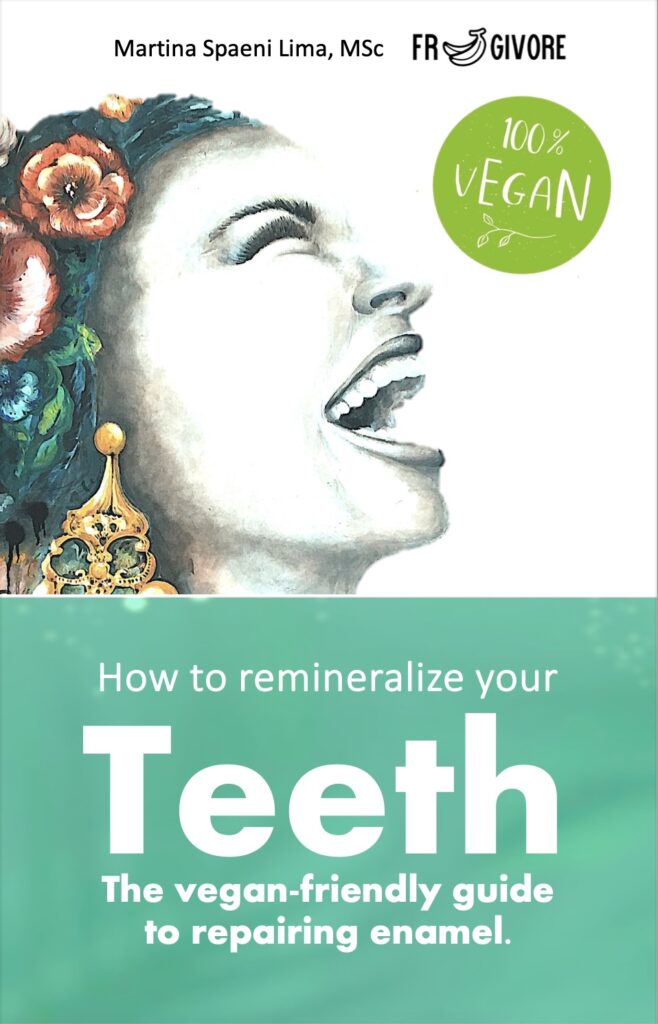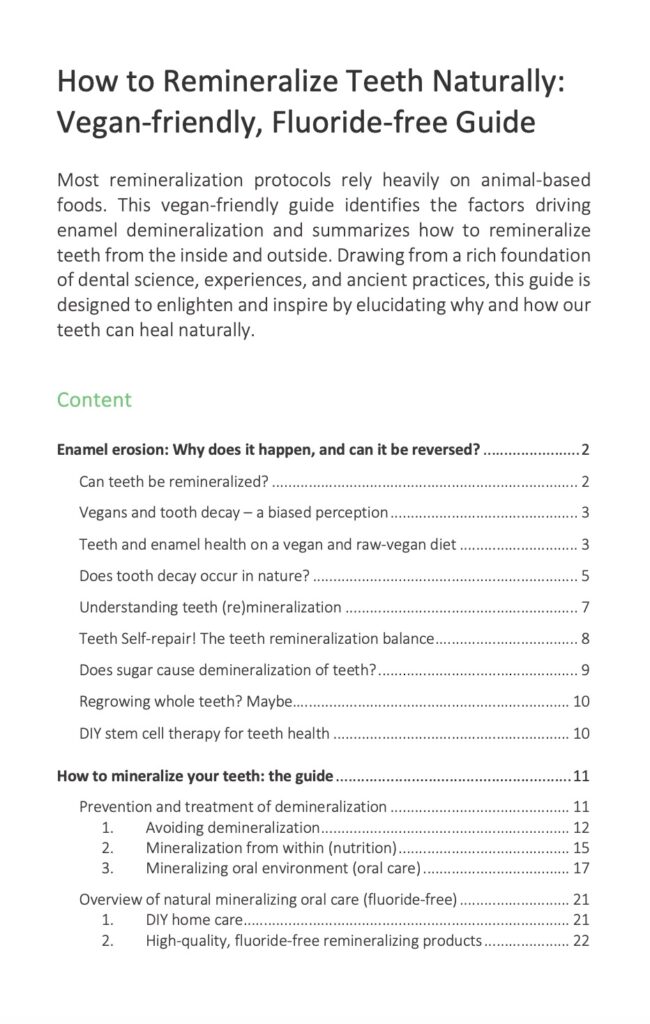Why are vegans and raw vegans sometimes said to be prone to tooth decay? This assumption is biased: we tend to pay more attention to health problems (such as tooth decay) in people who have adopted a “different” type of diet. On the other hand, people on a standard diet do not get as much attention if they have poor dental health, and yet people with all types of diets sit in the waiting rooms of dentists!
However, there are some factors of high raw and vegan diets that we should consider for best teeth health: Remineralization is a natural process that we can actively support if we know how it works.
Enamel remineralization guide
If you search for a teeth health protocol, you can download the guide on how to remineralize your teeth naturally:
Vegans and tooth decay – a biased perception
Generally, raw vegans have been shown to have better oral hygiene than cooked-food eaters and equal levels of cavities and tooth decay. However, regarding teeth health, the food chemistry of raw foods, such as acids in low-pH fruits, can wear off enamel over time. Luckily, eventual dental problems arising from a high-fruit diet can effectively be prevented and (to some degree) reversed.
Eating a raw alkaline-forming diet, in the long run, will ultimately help mineralize your teeth because the body will not be forced to mobilize calcium from teeth (and bones) to buffer the acid overload in the body. Over time, an alkaline-forming diet will improve your saliva composition, which is crucial to teeth health over time. During this transition, it’s essential to know how to protect our teeth from demineralization with a proper mineralization approach! Learn in-depth how remineralization works:
Can teeth be remineralized?
Yes, there are ways to mineralize teeth effectively, even naturally and as a vegan.
Enamel can be remineralized but not restored AND as long as the breakdown has not progressed too much and hasn’t reached the dentin layer. “What is gone is gone,” as I quote my dentist, stressing that once the enamel structure has broken down, it cannot be built up again. However, the remaining structure can be hardened (the hardening halts the decay); thus, not every cavity has to be drilled and filled. Demineralized white spot lesions can be mineralized and hardened (before the enamel structure breaks down) with effective methods, and thus, the decay can be reversed at this stage. Enamel decay due to frequent acid and sugar exposure or fruits and lack of remineralization (i.e., due to dry mouth) can be preventable.
“Remineralization of minor enamel defects is a normal physiological process that is well known to clinicians and researchers in dentistry and oral biology. This process can be facilitated by various dietary and oral hygiene procedures and may also concern dentin caries lesions. Dental caries is reversible if detected and treated sufficiently early.”
Mäkkinen et al. (2010)
Teeth and enamel health on a vegan and raw-vegan diet
Many people live years and decades on raw foods or even a fruitarian lifestyle and have perfectly healthy and strong teeth. Therefore, it wouldn’t be reasonable to blame diet alone. Fortunately, the raw community has many positive teeth health outcomes with improved gum and teeth health over time. There must be more to the story than diet alone: only if several factors come together do demineralization and cavities arise.
The leading cause of fast demineralization is an excessively acidic oral environment. When demineralization of enamel progresses faster than remineralization (see mineralization balance below), the enamel gets worn off over time and can break down. So, while it is not true that a raw or vegan diet inevitably leads to weak teeth, dental problems can emerge or worsen. Three main factors intensify enamel loss on a raw vegan diet:
- Frequent consumption of acidic fruits: Enamel erosion and other dental problems are not limited to the vegan or raw-vegan community. However, there are certain particularities and factors to consider for teeth health on a raw or high-fruit diet. Enamel is worn down faster by prolonged and frequent exposure to acid in fruits (especially unripe fruits or fruits high in acids) or the simple sugars in fruits, which feed acid-producing bacteria. This can lead to white spot lesions and smooth surface cavities. This type of enamel damage resembles the demineralization and caries seen in heavy soda pop drinkers (sugary acid drinks), resulting in decay in front teeth. To avoid the impact of this, there are many precautions that we can take on a daily basis and adopt a routine by minding our enamel integrity. Replacing acidic fruits with ripe tropical fruits is a huge factor here!
- Nutrient deficiency during transition: The body has a higher requirement for nutrients during the transition from a conventional diet to a more healthy diet. This can affect teeth and oral health, too. Therefore, taking supplements to support remineralization can be beneficial.
- Oral detoxification crisis: Transitioning to our biological species-appropriate diet most often leads to an extended or intense period of detox crisis, affecting teeth health. It is expected to experience sensitive teeth in this period, which is usually only temporary. During this period, it is critical to give your teeth extra attention: saliva tends to be more acidic during detoxification. Thus, regularly neutralizing the acidic oral environment with alkaline water, providing additional nutrients, and avoiding enamel erosion mistakes (see list below) are critical in the first months (or years) of adapting to a healthy diet. Once health is improved and the enamel is stronger, raw foods and fruits will likely not pose a problem to the enamel.
Does tooth decay occur in nature?
YES, tooth decay is also found among our closest relatives, the chimpanzees in the wild. Chimpanzees are frugivores: their diet in the wild consists mostly of ripe tropical fruits (depending on food availability). A feeding behavior called “wadging” in chimps can cause cavities and tooth decay in front teeth, as the animals “clamp” the fruit with their front teeth to suck out the juice of fruits. Wadging exposes the enamel to fruit acids and sugars over an extended period of time during the day.
So enamel erosion could be considered a natural problem on a high fruit (acid and sugary) raw vegan diet since human teeth have to last longer than chimp teeth due to a longer life span.
I was impressed when my new dentist noticed that my enamel problems looked like a case of a fruitarian diet or at least consuming fruits often. This indicated that a diet healthy for us, unfortunately, is not necessarily enamel-friendly: chemistry dictates that acids break down tooth enamel. However, there is a common mistake in high-fruit diets, especially in colder climates: acidic fruits should not be our main foods. A natural fruit diet is based on tropical, sweet fruits (read more here).
Thus a fruit-based diet can be tricky in terms of teeth. However, these issues are preventable in many cases – and keep in mind that meat-eaters and omnivores have dental problems, too.
Understanding teeth (re)mineralization
Natural remineralization is the deposition of calcium and phosphate within the enamel structure. Calcium and phosphate form the main component of enamel as calcium hydroxyapatite crystals. If fluoride is used as a mineralization agent, fluorapatite is produced instead, which has slightly different chemical properties than hydroxyapatite. Low pH (acid) dissolves the hydroxyapatite crystals. 95% of enamel is an inorganic material, mainly calcium hydroxyapatite, plus small amounts of trace elements (iron, magnesium, potassium, sulfur, etc.). Around 2% is organic material, including proteins, which are involved in enamel building (read a more in-depth article by Dogan, 2017).
Effective and fast remineralization is the key to strong teeth resistant to decay: mineralization is a dynamic process that is constantly in flux. To avoid enamel weakening, we need to mineralize faster than demineralization occurs. Meaning the rate of enamel mineral build-up has to be faster than the erosion and micro-decay.
Teeth remineralize on their own – given the right environment.
Teeth Self-repair
Teeth mineralization balance
The teeth mineralization balance basically describes how fast teeth replace the lost calcium compared to how fast they are stripped off by acids. Understanding this dynamic process is crucial for understanding how to mineralize your teeth effectively – and understanding how fluoride and natural compounds and remedies act to mineralize. In this way, we can elaborate on what we need to do to speed up mineralization and slow down demineralization!
This teeth decay balance is described in-depth by this article of Pocket Dentistry:
Demineralization is caused by acidic oral environment
- Acidic foods like vinegar, acidic fruits, unripe fruits
- Acid-producing biofilm (suboptimal oral bacteria composition)
- dry mouth (not enough saliva)
- sub-optimal and acid saliva composition (not enough minerals, high pH water)
- frequent drinking and eating of fermentable carbs (feeding the acid-producing bacterias)
- poor oral hygiene (not removing acids or the acid-producing bacteria)

Remineralization is caused by alkalinity and enamel building blocks
Saliva flow and components (minerals, alkalinity), Remineralizing components that we can add (calcium, phosphates, and others), antibacterial agents (reduce acid-producing bacteria), good oral hygiene
- Healthy saliva flow
- Healthy saliva composition (minerals, alkalinity)
- Remineralizing components that we can add (calcium, hydroxyapatite)
- Antibacterial agents (reduce acid-producing bacteria)
- Reducing the build-up of a biofilm by good oral hygiene
- Healthy microbiome compsoition
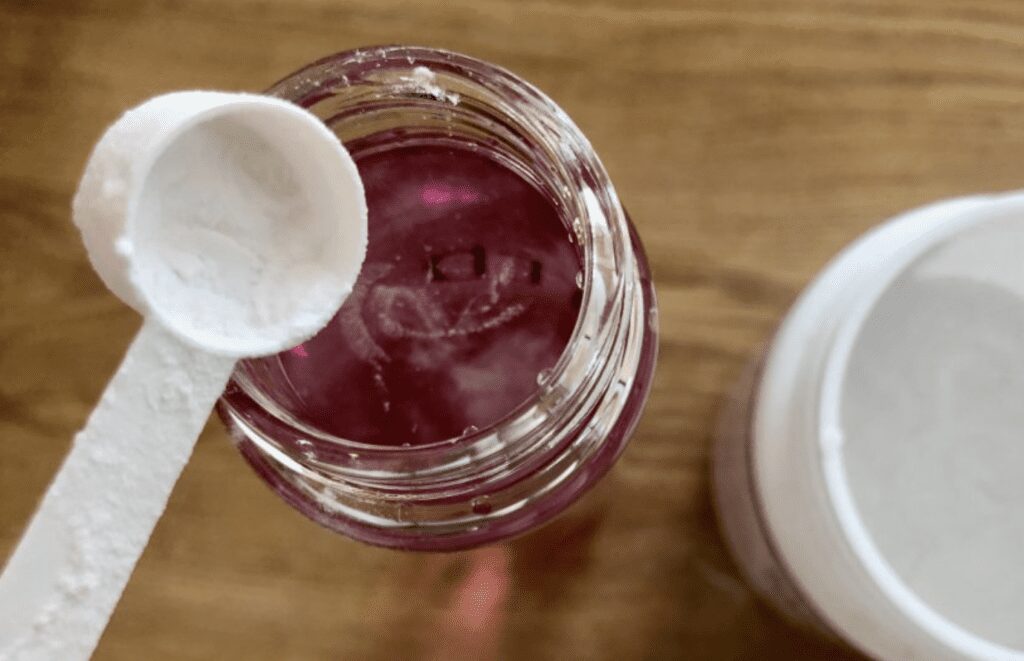
For detailed instructions on how to remineralize enamel without fluoride, visit our vegan-friendly remineralization guide!
Does sugar cause demineralization of teeth?
No, sugar alone does not stripe minerals from teeth. But can sugary foods lead to decay? Yes, indirectly, it can: while sugar itself does not hurt the enamel, it feeds the cavity-causing bacteria that produce the acids. When there is an accumulation of bacteria (a biofilm) on top of the tooth surface, the enamel is exposed to the bacterial acids over time. To prevent this cariogenic environment, removing the biofilm is a decisive factor in decay.
It is not the sugar; it’s the acid! Sugar does NOT break down enamel. Acid does. Sugar does feed bacteria that produce acid (they ferment the sugar to acid). Without the bacteria biofilm sticking to your teeth, sugar alone won’t break down enamel.
Another Sugar Myth
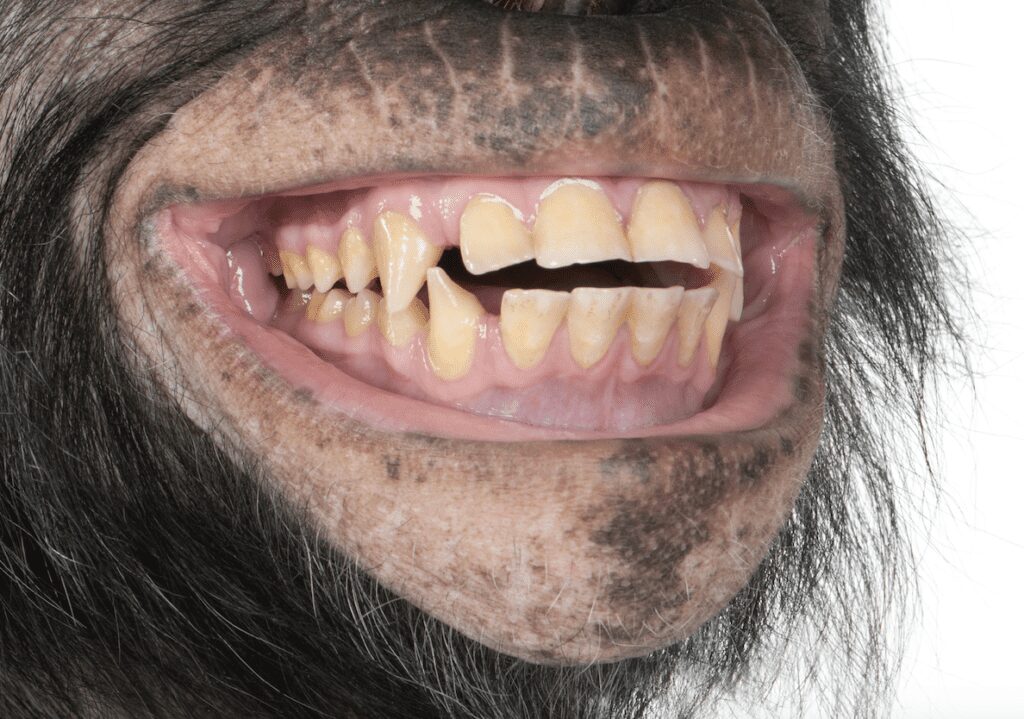
Chimpanzees eat sweet, sugary fruits all day long (up to 6 kilos per day) – but rarely acidic fruits! On a high-raw diet, it is essential to understand that primates are tropical (sweet) fruit eaters!
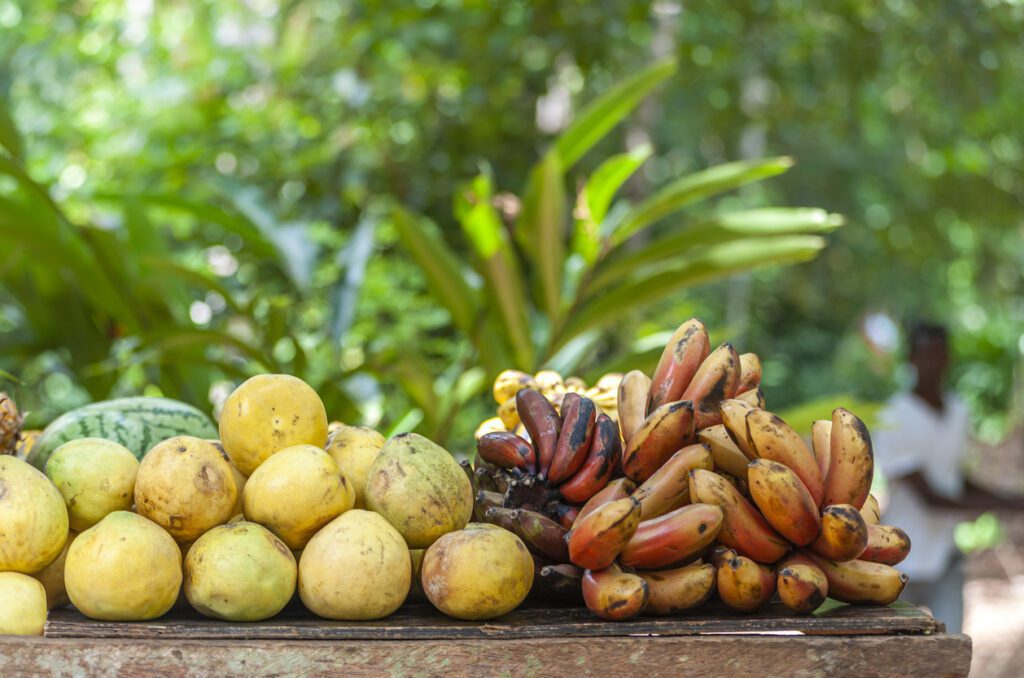
Thus tropical sweet fruits are the main natural food source also for humans, while most acidic fruits (temperate fruits) have evolved as bird foods (read more here).
Regrowing whole teeth? maybe…
Some out-of-the-box stories and pictures of whole teeth regrowing appear at times. We all really want this to be true, yet most have never witnessed it for themselves. Is regrowing teeth possible? It seems, at least in the lab, it is… there are reports since 2004 that teeth have been regrown in rats using stem cells.
I do not have a conclusive opinion on this, but science has shown that teeth have their own stem cells, which are currently used in promising tooth engineering research. Read more about stem cells and teeth in the last section of this guide. Unfortunately, experimental dentistry seems far away from providing a stem cell solution, so we need to stick to natural remineralization for now.
DIY stem cell therapy for teeth health
Dental stem cells for tooth regeneration have been known in science for a while and are investigated in dental engineering. However, we don’t find a practical application at the dentist. We can’t speed up science, but we can always use nature’s treasures and resources! We have stem cells in many depots, fluids, and tissues, such as fat tissue and blood and lymph. But we also have easily accessible sources such as urine and menstrual blood. Thus, as crazy and impossible as it may sound – there are DIY stem cell home remedies:
Stem cells in urine: This is no joke, but rather stunning! Urine stem cells have already been used to regrow teeth in science, and in yogic religion morning, urine drinking is a common practice. In Ayurveda healing art, the method of oral urine swishing in the morning is known for dental health improvement. Modern science explains some of the mechanisms, i.e., that one of the “miracle ingredients” in urine is stem cells.
Stem cells in menstrual blood: no joke. Menstrual blood can be rubbed on receding gingival gums, which can regrow within weeks and even days if the damage is not too extended. Yes, regrow gums. Just place drops of menstrual blood on affected areas and leave them for as long as possible. Menstrual blood has been discovered as an easy-to-access (non-invasive) source of stem cells in regenerative medicine, i.e., epidermal tissue.
References
- Sijanivandi, S. et al. (2020) “Effects of raw vegan diet on periodontal and dental parameters,” Tzu Chi Medical Journal, 32(4), p. 357. Available at: https://doi.org/10.4103/tcmj.tcmj_161_19.
- Mäkinen, K.K. (2010) “Sugar alcohols, caries incidence, and remineralization of caries lesions: A literature review,” International Journal of Dentistry, 2010, pp. 1–23. Available at: https://doi.org/10.1155/2010/981072.
- Ritter, A.V. et al. (2015) Dental caries: Etiology, clinical characteristics, risk assessment, and Management, Pocket Dentistry. Available at: https://pocketdentistry.com/2-dental-caries-etiology-clinical-characteristics-risk-assessment-and-management/ (Accessed: April 11, 2023).
- Ren, Y. et al. (2014) “Orthodontic treatment with fixed appliances and biofilm formation—a potential public health threat?,” Clinical Oral Investigations, 18(7), pp. 1711–1718. Available at: https://doi.org/10.1007/s00784-014-1240-3.
- Southview Dentistry (2021) The truth about soda and acid erosion on teeth, Southview Dentistry. Available at: https://www.southviewdentistrycharlotte.com/acid-erosion-the-truth-about-soda-and-your-teeth/ (Accessed: April 11, 2023).
- Mead, A. (2012) Pop cavities. mead family dental Available at: https://meadfamilydental.com/2012/05/pop-cavities/ (Accessed: April 11, 2023).
- Towle, I. (2023) We’ve proved that wild primates suffer from tooth decay – and chimps are among the worst. The Conversation. Available at: https://theconversation.com/weve-proved-that-wild-primates-suffer-from-tooth-decay-and-chimps-are-among-the-worst-173385 (Accessed: April 11, 2023).
- Remineralization of teeth (2022) Wikipedia. Wikimedia Foundation. Available at: https://en.wikipedia.org/wiki/Remineralisation_of_teeth (Accessed: April 11, 2023).
- Doğan, M.S. (2018) Relation of trace elements on Dental Health, IntechOpen. IntechOpen. Available at: https://www.intechopen.com/chapters/60356 (Accessed: April 11, 2023).
- Themes, U.F.O. (2015) 2: Dental caries: Etiology, clinical characteristics, risk assessment, and Management, Pocket Dentistry. Available at: https://pocketdentistry.com/2-dental-caries-etiology-clinical-characteristics-risk-assessment-and-management/ (Accessed: April 11, 2023).
- Tytell E.D. (2004) Scientists regrow teeth in rats using stem cells. Los Angeles Times. Available at: https://www.latimes.com/archives/la-xpm-2004-jun-26-sci-teeth26-story.html (Accessed: April 11, 2023).
- Lymperi, S. et al. (2013) “Dental Stem Cells and their applications in dental tissue engineering,” The Open Dentistry Journal, 7(1), pp. 76–81. Available at: https://doi.org/10.2174/1874210601307010076.
- Lymperi, S. et al. (2013) “Dental Stem Cells and their applications in dental tissue engineering,” The Open Dentistry Journal, 7(1), pp. 76–81. Available at: https://doi.org/10.2174/1874210601307010076.
- Castillo, M. (2013) Scientists grow teeth out of urine, CBS News. CBS Interactive. Available at: https://www.cbsnews.com/news/scientists-grow-teeth-out-of-urine/ (Accessed: April 11, 2023).
- Mills, M.H. and Faunce, T.A. (1991) “Melatonin supplementation from early morning auto-urine drinking,” Medical Hypotheses, 36(3), pp. 195–199. Available at: https://doi.org/10.1016/0306-9877(91)90129-m.
- Zhou, Q. et al. (2022) “A comprehensive review of the therapeutic value of urine-derived stem cells,” Frontiers in Genetics, 12. Available at: https://doi.org/10.3389/fgene.2021.781597.
- Faramarzi, H. et al. (2016) The potential of menstrual blood-derived stem cells in differentiation to epidermal lineage: A preliminary report. World journal of plastic surgery, 5(1): 26–31. Available at: https://pubmed.ncbi.nlm.nih.gov/27308237/ (Accessed: April 11, 2023).


